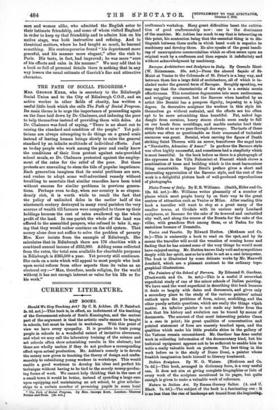Nature in Italian Art. By Emma Gurney Salter. (A. and
C. Black. 7s. 6d.)—The subject of the book is a fascinating one : it is no less than the rise of landscape art traced from the beginning.
Miss Salter notes that it was not till portraiture began in the fifteenth century that painters took to portraying actual landscape forms. Before backgrounds bad been symbolical, then by degrees plants and flowers were painted individually, and later came mountain; woods, and rivers. One of the first artists to make real use of landscape effects was Piero della Francesca, as may be seen in his Baptism in the National Gallery, where the reflections in the stream are astonishingly real. Miss Salter notes Piero's tendency to passages of drab colour on his hillsides, and suggests fading of the paints as the explanation. Is it not, however, a desire to represent the grey marl on which bushes are scattered which gives a peculiar character to certain parts of Central Italy that has produced this result? Leonardo was more advanced in his drawings of landscape than in his painting; indeed, in one drawing of a storm over the Alps lie antici- pates Turner. It was reserved for the Venetians to bring landscape in itself into prominence, and Giorgione may be said to have created a new art in which the landscape is on an equality with the figures. Titian and Tintoretto went still further, and their landscapes are full of observation of natural effects. Still it is doubtful if they ever attained that intimate sympathy with the living spirit of nature which in modern times we
associate with Wordsworth, but which was reached by Giorgione in such a work as his Concert Champetre in the Louvre. We are
very grateful to Miss Salter for the careful and scholarly way in which she has gathered together such a great quantity of in- formation upon this interesting subject.



































































 Previous page
Previous page